Estimating Tropical Cyclone Size in the Northwestern Pacific from Geostationary Satellite Infrared Images
Abstract
:1. Introduction
2. Datasets
3. Correlation between TC Size and TC Cloud-Top Brightness Temperature
4. Establishing Models for the Estimation of the Size of TCs and Evaluation with Different Series of Satellite Data
5. TC Size Dataset Derived from Satellite Observations in the NWP
5.1. Comparison of TC Size Estimation Result with Different Satellite Data Series
5.2. TC Size Dataset in the NWP Covering 1980 and 2009
5.3. TC Size Climatology
5.4. Correlation between TC Size and Intensity
6. Summary
Acknowledgments
Author Contributions
Conflicts of Interest
References
- Chen, L.S.; Ding, Y.H. Tropical Cyclones in Northwestern Pacific, 1st ed.; China Science Press: Beijing, China, 1979; pp. 16–17. (In Chinese) [Google Scholar]
- Zhang, Q.P.; Lai, L.L.; Sun, W.C. Location of tropical cyclone center with intelligent image processing technique, ICMLC 2005, Lect. Notes Artif. Intell. 2005, 3930, 898–907. [Google Scholar]
- Merrill, R.T. A Comparison of large and small tropical cyclones. Mon. Weather Rev. 1984, 112, 1408–1418. [Google Scholar] [CrossRef]
- Liu, K.S.; Chan, J.C.L. Size of Tropical cyclone as inferred from ERS-1 and ERS-2 Data. Mon. Weather Rev. 1999, 127, 2992–3001. [Google Scholar] [CrossRef]
- Knaff, J.A.; Longmore, S.P.; Molenar, D.A. An objective satellite-based tropical cyclone size climatology. J. Clim. 2014, 27, 455–476. [Google Scholar] [CrossRef]
- Knaff, J.A.; Slocum, C.J.; Musgrave, K.D.; Sampson, C.R.; Strahl, B.R. Using Routinely Available Information to Estimate Tropical Cyclone Wind Structure. Mon. Weather Rev. 2016, 144, 1233–1247. [Google Scholar] [CrossRef]
- Zhang, G.S.; Li, X.; Perrie, W.; Zhang, B.; Wang, L. Rain effects on the hurricane observations over the ocean by C-band Synthetic Aperture Radar. J. Geophys. Res. Oceans 2015, 120, 14–26. [Google Scholar] [CrossRef]
- Holland, G. An Analytic Model of the Wind and Pressure Profiles in Hurricanes. Mon. Weather Rev. 1980, 108, 1212–1218. [Google Scholar] [CrossRef]
- Elsberry, R.L. A global View of Tropical Cyclones, 1st ed.; Chen, L.S., Dong, K.Q., Jin, H.L., Bao, D.L., Qin, C.H., Eds.; China Meteorological Press: Beijing, China, 1994; pp. 243–264. (In Chinese) [Google Scholar]
- Zou, X.L.; Xiao, Q.N. Studies on the initialization and simulation of a mature hurricane using a variational bogus data assimilation scheme. J. Atmos. Sci. 1999, 57, 836–860. [Google Scholar] [CrossRef]
- Knaff, J.A.; DeMaria, M.; Molenar, D.A.; Sampson, C.R.; Seybold, M.G. An automated, objective, multi-satellite platform tropical cyclone surface wind analysis. J. Appl. Meteorol. Climatol. 2011, 50, 2149–2166. [Google Scholar] [CrossRef]
- Lu, X.Q.; Yu, H.; Lei, X.T. Statistics for size and radial wind profile of tropical cyclones in the western North Pacific. Acta Meteorol. Sin. 2011, 25, 104–112. [Google Scholar] [CrossRef]
- Wu, L.; Tian, W.; Liu, Q.; Cao, J.; Knaff, J.A. Implications of the observed relationship between tropical cyclone size and intensity over the western North Pacific. J. Clim. 2015, 28, 9501–9506. [Google Scholar] [CrossRef]
- Cocks, S.B.; Gray, W.M. Variability of the outer wind profiles of western North Pacific typhoons: Classifications and techniques for analysis and forecasting. Mon. Weather Rev. 2002, 130, 1989–2005. [Google Scholar] [CrossRef]
- Jin, S.; Wang, S.; Li, X. Typhoon eye extraction with an automatic SAR image segmentation method. Int. J. Remote Sens. 2014, 35, 3978–3993. [Google Scholar] [CrossRef]
- Lee, I.; Shamsoddini, A.; Li, X.; Trinder, J.C.; Li, Z. Extracting hurricane eye morphology from spaceborne SAR images using morphological analysis. ISPRS J. Photogramm. Remote Sens. 2016, 7, 115–125. [Google Scholar] [CrossRef]
- Zheng, G.; Yang, J.; Liu, A.K.; Li, X.; Pichel, W.G.; He, S. Comparison of typhoon centers from SAR and IR images and those from best track datasets. IEEE Trans. Geosci. Remote Sens. 2016, 54, 1000–1012. [Google Scholar] [CrossRef]
- Jin, S.; Wang, S.; Li, X.; Jiao, L.; Zhang, J.A.; Shen, D. Center location of tropical cyclones without eyes in SAR images based on salient region detection and pattern matching. IEEE Trans. Geosci. Remote Sens. 2017. [Google Scholar] [CrossRef]
- Friedman, K.; Li, X. Storm patterns over the ocean with wide swath SAR. Johns Hopkins Univ. APL Tech. Dig. 2000, 21, 80–85. [Google Scholar]
- Li, X.; Zhang, J.A.; Yang, X.; Pichel, W.G.; DeMaria, M.; Long, D.; Li, Z. Tropical cyclone morphology from spaceborne synthetic aperture radar. Bull. Am. Meteorol. Soc. 2013. [Google Scholar] [CrossRef]
- Li, X. The First Sentinel-1 SAR Image of a Typhoon. Acta Oceanol. Sin. 2015, 34, 1–2. [Google Scholar] [CrossRef]
- Zhou, X.; Yang, X.; Li, Z.; Yu, Y.; Bi, H.; Ma, S.; Li, X. Estimation of tropical cyclone parameters and wind fields from SAR images. Sci. China Earth Sci. 2013, 56, 1977–1987. [Google Scholar] [CrossRef]
- Zhang, G.S.; Perrie, W.; Li, X.; Zhang, J.A. A Hurricane morphology and surface wind vector estimation model for C-band cross-polarization SAR. IEEE Trans. Geosci. Remote Sens. 2017, 55, 1743–1751. [Google Scholar] [CrossRef]
- Li, X.; Pichel, W.; He, M.; Wu, S.; Friedman, K.; Clemente-Colon, P.; Zhao, C. Observation of Hurricane-Generated Ocean Swell Refraction at the Gulf Stream North Wall with the RADARSAT-1 Synthetic Aperture Radar. IEEE Trans. Geosci. Remote Sens. 2002, 40, 2131–2142. [Google Scholar] [CrossRef]
- Kimball, S.K.; Mulekar, M.S. A 15-year climatology of North Atlantic tropical cyclones. Part I: Size parameters. J. Clim. 2004, 17, 3555–3575. [Google Scholar] [CrossRef]
- Lee, C.S.; Cheung, K.K.W.; Fang, W.T.; Elsberry, R.L. Initial maintenance of tropical cyclone size in the western North Pacific. Mon. Weather Rev. 2010, 138, 3207–3223. [Google Scholar] [CrossRef]
- Chan, K.T.F.; Chan, J.C.L. Size and strength of tropical cyclones as inferred from QuikSCAT data. Mon. Weather Rev. 2012, 140, 811–824. [Google Scholar] [CrossRef]
- Chan, K.T.F.; Chan, J.C.L. Angular momentum transports and synoptic flow patterns associated with tropical cyclone size change. Mon. Weather Rev. 2013, 141, 3985–4007. [Google Scholar] [CrossRef]
- Brand, S. Very large and very small typhoon of the Western North Pacific Ocean. J. Meteorol. Soc. Jpn. 1972, 50, 332–341. [Google Scholar] [CrossRef]
- Carr, L.E., III; Elsberry, R.L. Models of tropical cyclone wind distribution and beta-effect propagation for application to tropical cyclone track forecasting. Mon. Weather Rev. 1997, 125, 3190–3209. [Google Scholar] [CrossRef]
- Demuth, J.L.; Demaria, M.; Knaff, J.A. Improvement of Advanced Microwave Sounding Unit Tropical Cyclone Intensity and Size Estimation Algorithms. J. Appl. Meteorol. Climatol. 2006, 45, 1573–1581. [Google Scholar] [CrossRef]
- Kossin, J.P.; Knaff, J.A.; Berger, H.I.; Herndon, D.C.; Cram, T.A.; Velden, C.S.; Murnane, R.J.; Hawkins, J.D. Estimating hurricane wind structure in the absence of aircraft reconnaissance. Weather Forecast. 2007, 22, 89–101. [Google Scholar] [CrossRef]
- Lajoie, F.; Walsh, K. A Technique to Determine the Radius of Maximum Wind of a Tropical Cyclone. Weather Forecast. 2008, 23, 1007–1015. [Google Scholar] [CrossRef]
- Dvorak, V.F. Tropical Cyclone Intensity Analysis and Forecasting from Satellite Imagery. Mon. Weather Rev. 1975, 103, 420–430. [Google Scholar] [CrossRef]
- Dvorak, V.F. Tropical Cyclone Intensity Analysis Using Satellite Data; National Oceanic and Atmospheric Administration, National Environmental Satellite, Data, and Information Service: Washington, DC, USA, 1984; pp. 2–15.
- Knaff, J.A.; Sampson, C.R.; Demaria, M.; Marchok, T.P.; Gross, J.M.; Mcadie, C.J. Statistical Tropical Cyclone Wind Radii Prediction Using Climatology and Persistence. Weather Forecast. 2007, 22, 781–791. [Google Scholar] [CrossRef]
- Knapp, K.R.; Kruk, M.C.; Levinson, D.H.; Diamond, H.J.; Neumann, C.J. The International Best Track Archive for Climate Stewardship (IBTrACS): Unifying tropical cyclone best track data. Bull. Am. Meteorol. Soc. 2010, 91, 363–376. [Google Scholar] [CrossRef]
- Knapp, K.R.; Kossin, J.P. New global tropical cyclone data from ISCCP B1 geostationary satellite observations. J. Appl. Remote Sens. 2007, 1, 013505. [Google Scholar] [CrossRef]
- Knapp, K.R.; Ansari, S.; Bain, C.L.; Bourassa, M.A.; Dickinson, M.J.; Funk, C.; Helms, C.N.; Hennon, C.C.; Holmes, C.D.; Huffman, G.J.; et al. Globally Gridded Satellite Observations for Climate Studies. Bull. Am. Meteorol. Soc. 2011, 92, 893–907. [Google Scholar] [CrossRef]
- Hennon, C.C.; Helms, C.N.; Knapp, K.R.; Bowen, A.R. An objective algorithm for detecting and tracking tropical cloud clusters: Implications for tropical cyclogenesis prediction. J. Atmos. Ocea. Technol. 2011, 28, 1007–1018. [Google Scholar] [CrossRef]
- Bain, C.L.; Paz, J.D.; Kramer, J.; Magnusdottir, G.; Smyth, P.; Stern, H.; Wang, C.C. Detecting the ITCZ in instantaneous satellite data using spatial–temporal statistical modeling: ITCZ climatology in the east Pacific. J. Clim. 2011, 24, 216–230. [Google Scholar] [CrossRef]
- Lee, C.S. Observational analysis of tropical cyclogenesis in the western North Pacific. Part I: Structural evolution of cloud clusters. J. Atmos. Sci. 1989, 46, 2580–2598. [Google Scholar] [CrossRef]
- Shapiro, L.J.; Willoughby, H.E. The response of balanced hurricanes to local sources of heat and momentum. J. Atmos. Sci. 1982, 39, 378–394. [Google Scholar] [CrossRef]
- Shea, D.J.; Gray, W.M. The hurricane’s inner core region. I. Symmetric and asymmetric structure. J. Atmos. Sci. 1973, 30, 1544–1564. [Google Scholar] [CrossRef]
- Weatherford, C.L.; Gray, W.M. Typhoon structure as revealed by aircraft reconnaissance. Part I: Data analysis and climatology. Mon. Weather Rev. 1988, 116, 1032–1043. [Google Scholar] [CrossRef]
- Weatherford, C.L.; Gray, W.M. Typhoon structure as revealed by aircraft reconnaissance. Part II: Structural variability. Mon. Weather Rev. 1988, 116, 1044–1056. [Google Scholar] [CrossRef]
- Croxford, M.; Barnes, G.M. Inner core strength of Atlantic tropical cyclones. Mon. Weather Rev. 2002, 130, 127–139. [Google Scholar] [CrossRef]
- McAdie, C.J. Development of a wind-radii CLIPER model. In Proceedings of the 26th Conference on Hurricanes and Tropical Meteorology, Miami, FL, USA, 2–7 May 2004. [Google Scholar]
- Ohring, G. Application of Stepwise Multiple Regression Techniques to Inversion of Nimbus “IRIS” Observations. Mon. Weather Rev. 1972, 100, 336–344. [Google Scholar] [CrossRef]
- Smith, W.L.; Woolf, H.M.; Jacob, W.J. A Regression Method for Obtaining Real-Time Temperature and Geopotential Height Profiles From Satellite Spectrometer Measurements and Its Application to NIMBUS 3 ‘SIRS’ Observations. Mon. Weather Rev. 1970, 98, 582–603. [Google Scholar] [CrossRef]
- Knaff, J.A.; Harper, B.A. Tropical cyclone surface wind structure and wind-pressure relationships. In Proceedings of the WMO Seventh International Workshop on Tropical Cyclones, La Reunion, France, 15–20 November 2010. [Google Scholar]
- Knaff, J.A.; Sampson, C.R. After a decade are Atlantic tropical cyclone gale force wind radii forecasts now skillful? Weather Forecast. 2015, 30, 702–709. [Google Scholar] [CrossRef]
- Xie, L.; Bao, S.; Pietrafesa, L.J.; Foley, K.; Fuentes, M. A real-time hurricane surface wind forecasting model: Formulation and verification. Mon. Weather Rev. 2006, 134, 1355–1370. [Google Scholar] [CrossRef]
- Chen, D.Q.; Chen, X.Z.; Feng, J.X. Climatological Atlas for Northwestern Pacific Tropical Cyclones, 1st ed.; China Climatological Press: Beijing, China, 1990; pp. 8–17. [Google Scholar]
- Barcikowska, M.; Feser, F.; Von Storch, H. Usability of best track data in climate statistics in the western north pacific. Mon. Weather Rev. 2012, 140, 2818–2830. [Google Scholar] [CrossRef]
- Ren, F.; Liang, J.; Wu, G.; Dong, W.; Yang, X. Reliability analysis of climate change of tropical cyclone activity over the western north pacific. J. Clim. 2011, 24, 5887–5898. [Google Scholar] [CrossRef]
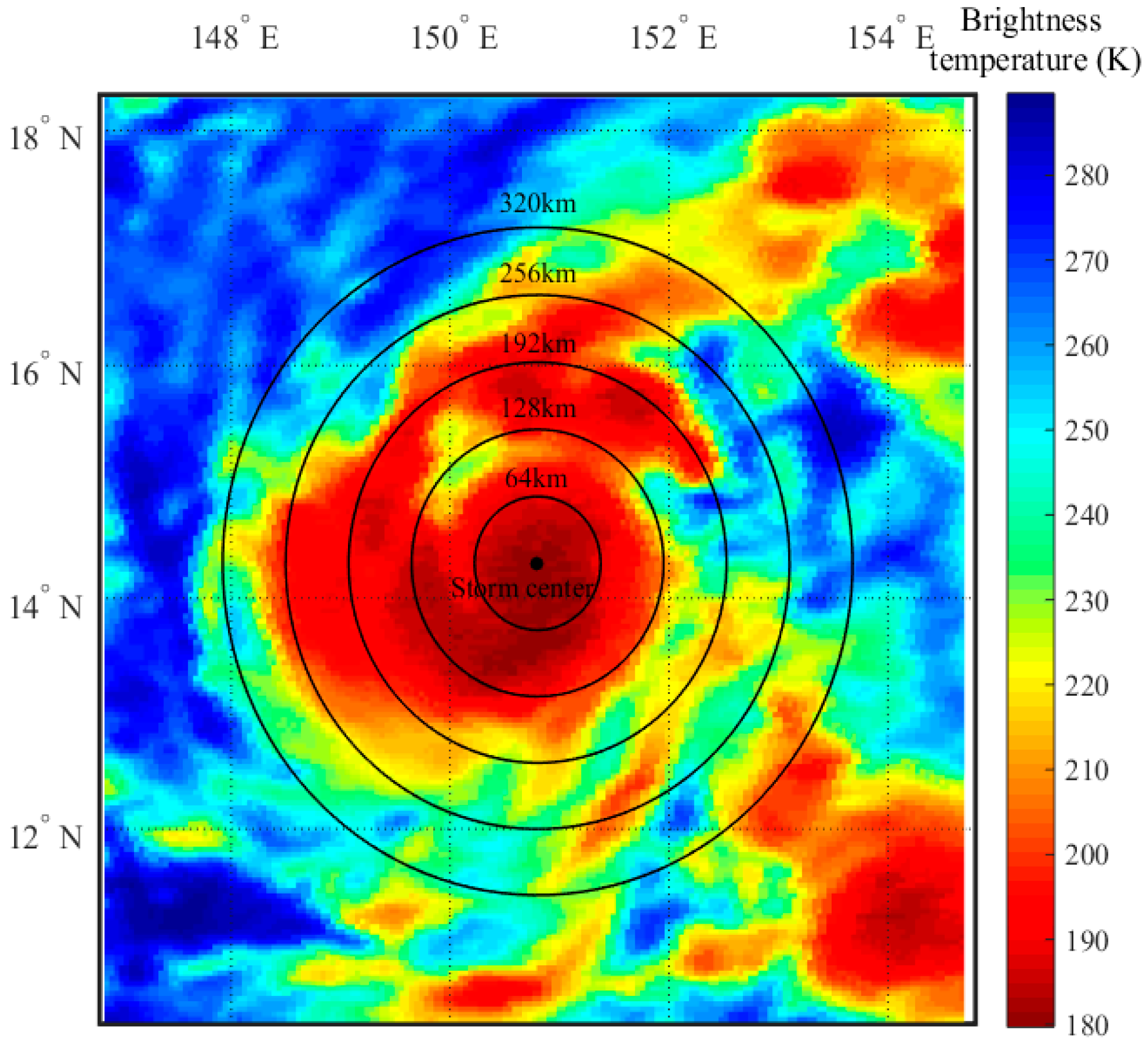
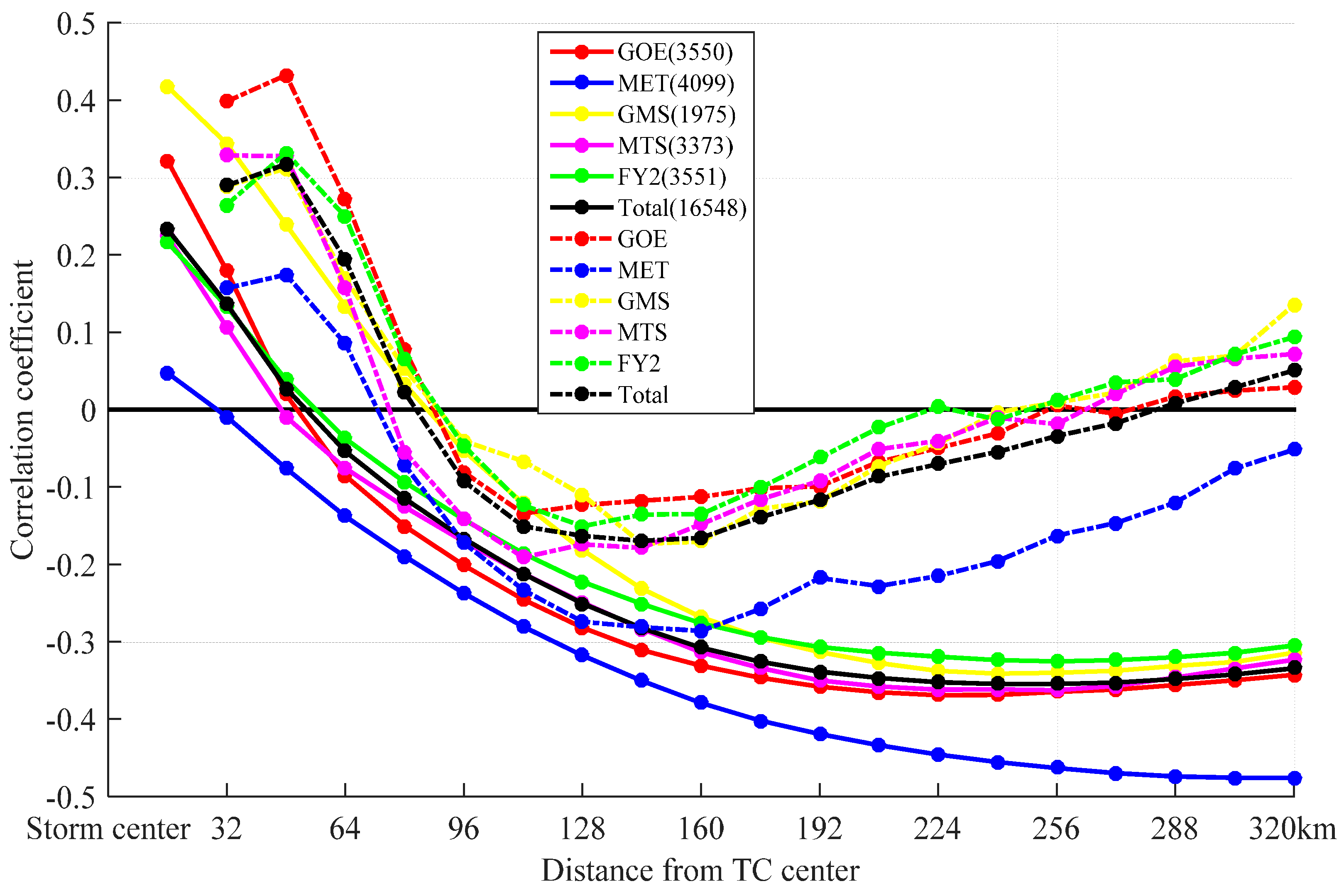
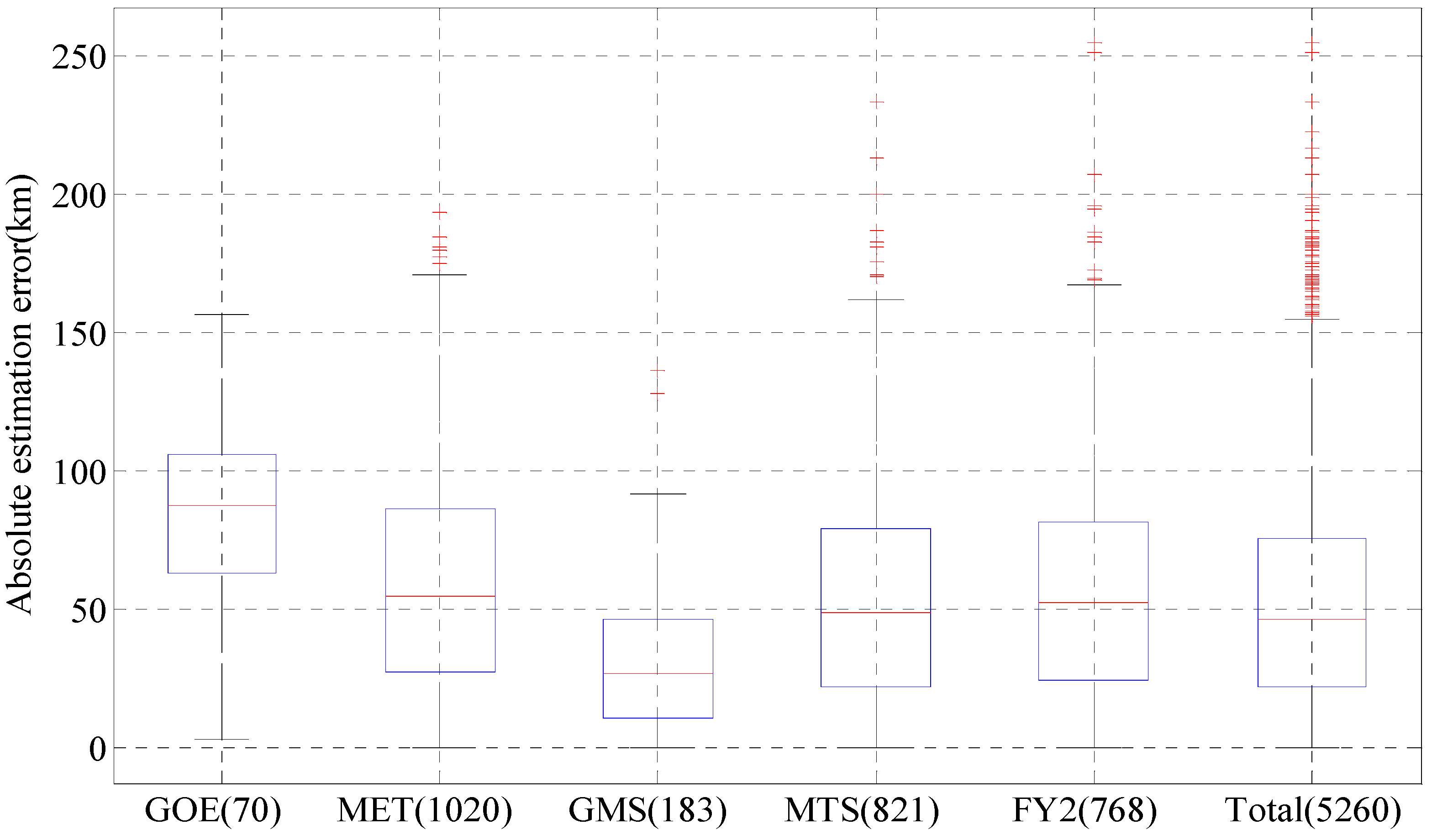

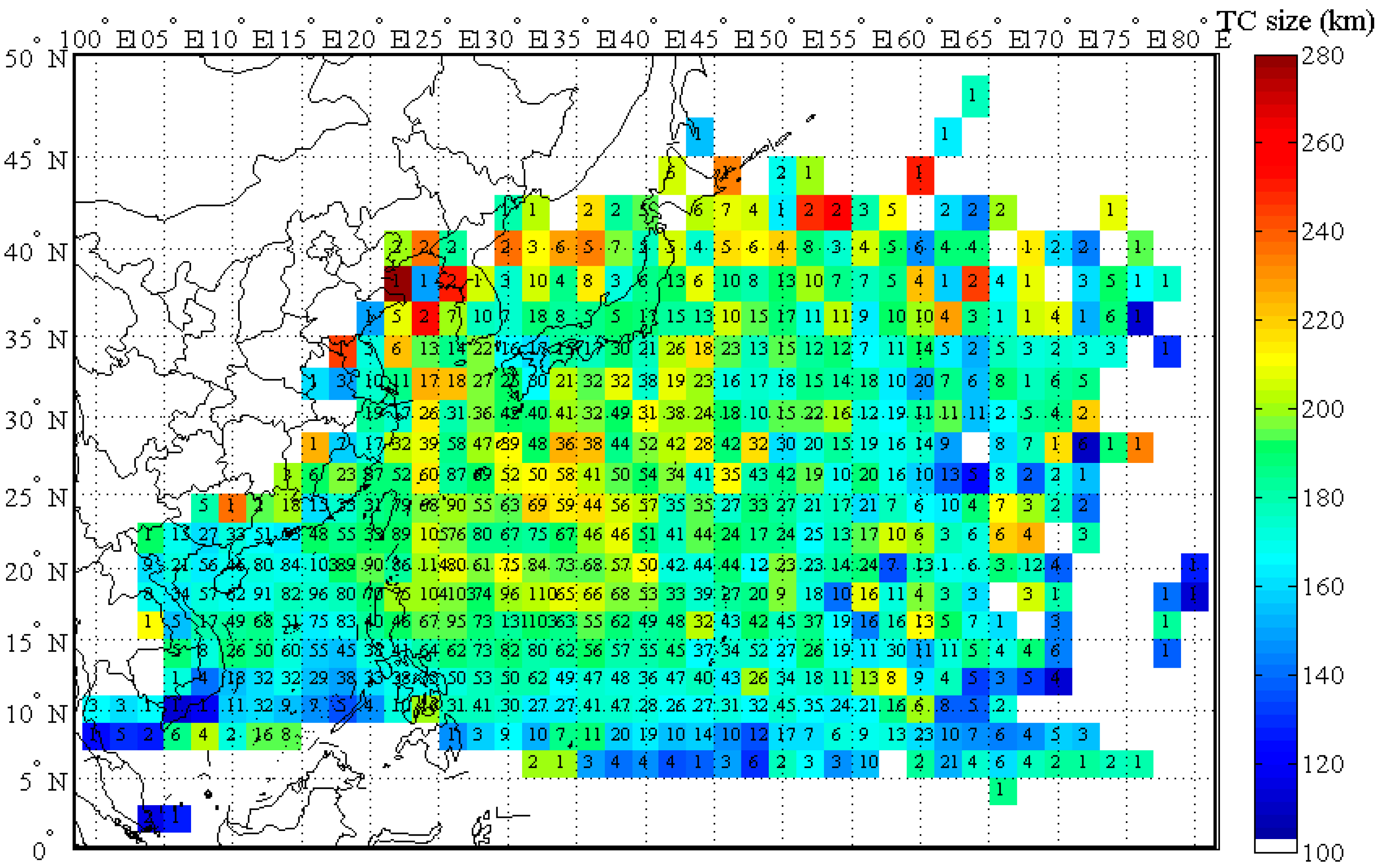
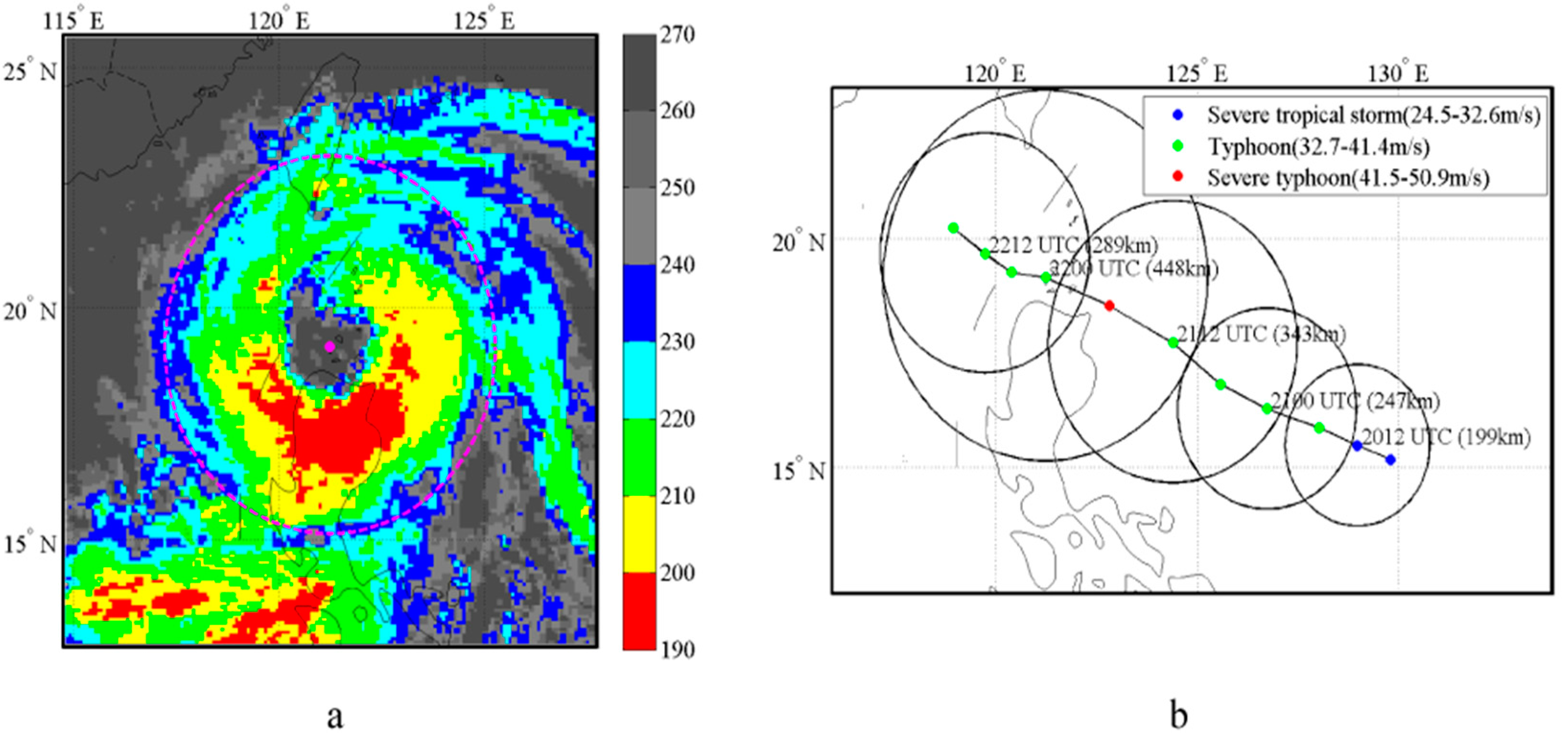
| Satellite | Time Period | No. of TCs | Sample Size | Dependent Sample Size (Time) | Independent Sample Size (Time) |
|---|---|---|---|---|---|
| GOES | 2001–2009 | 85 | 3550 | 3480 (2001–2006) | 70 (2007–2009) |
| MET | 2001–2009 | 132 | 4099 | 3079 (2001–2006) | 1020 (2007–2009) |
| FY2 | 2005–2009 | 97 | 3551 | 2783 (2005–2008) | 768 (2009) |
| MTS | 2005–2009 | 85 | 3373 | 2552 (2005–2008) | 821 (2009) |
| GMS | 2001–2003 | 49 | 1975 | 1792 (2001–2002) | 183 (2003) |
| Total | 2001–2009 | 197 | 16,548 | 11,288 (2001–2006) | 5260 (2007–2009) |
| Different samples | Satellite | MET | GOES | GMS |
| Time period | 1988–2009 | 1980–2009 | 1981–2003 | |
| Sample size | 5249 | 5302 | 26416 | |
| Mean TC size (km) | 147 | 146 | 175 | |
| Standard deviation (km) | 44 | 45 | 51 | |
| Same sample comparison | Satellite | GMS vs. MET | GMS vs. GOES | MET vs. GOES |
| Time period | 1988–2003 | 1981–2003 | 2003–2005 | |
| Sample size | 2476 | 2019 | 1114 | |
| Mean absolute difference (km) | 33 | 36 | 11 |
| Basin | This Study | Lu (2011) | Liu and Chan (1999) | Merrill (1984) | Knaff (2014) | |
|---|---|---|---|---|---|---|
| R34 (km) | R34 (km) | Rv10−5 (° lat) | R30 (° lat) | ROCI (° lat) | R5 (° lat) | |
| NWP | 184 (50) | 203 (76) | 3.7 (1.1) | 2.9 (1.1) | 4.4 (2.0) | 11 (3.36) |
© 2017 by the authors. Licensee MDPI, Basel, Switzerland. This article is an open access article distributed under the terms and conditions of the Creative Commons Attribution (CC BY) license (http://creativecommons.org/licenses/by/4.0/).
Share and Cite
Lu, X.; Yu, H.; Yang, X.; Li, X. Estimating Tropical Cyclone Size in the Northwestern Pacific from Geostationary Satellite Infrared Images. Remote Sens. 2017, 9, 728. https://doi.org/10.3390/rs9070728
Lu X, Yu H, Yang X, Li X. Estimating Tropical Cyclone Size in the Northwestern Pacific from Geostationary Satellite Infrared Images. Remote Sensing. 2017; 9(7):728. https://doi.org/10.3390/rs9070728
Chicago/Turabian StyleLu, Xiaoqin, Hui Yu, Xiaoming Yang, and Xiaofeng Li. 2017. "Estimating Tropical Cyclone Size in the Northwestern Pacific from Geostationary Satellite Infrared Images" Remote Sensing 9, no. 7: 728. https://doi.org/10.3390/rs9070728






